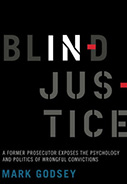Blind Injustice: A Former Prosecutor Exposes The Psychology And Politics Of Wrongful Convictions

Author; Mark Godsey
Publisher: Oakland, CA: University of California Press, 2017. 254p.
Reviewer: Rick Sarre | July 2018
If, like me, you enjoyed the Netflix ‘docudrama’ Making A Murderer, you will be right at home with this excellent exposé of certain problematic features of the American criminal justice system. Former prosecutor, now professor, Mark Godsey takes his readers through a multitude of cases in which he acted as legal counsel, and where wrongful convictions emerged at the end of the day. The fact that this leading light in the Ohio Innocence Project was on the ‘other side’ of the justice ‘coin’ for many years, employing the same tactics that are likely to give rise to mistakes, gives his writing the credibility that other ‘justice system in crisis’ or ‘criminal injustice system’ books simply do not have.
Godsey notes that, nationally, more than two thousand people have been identified as victims of wrongful convictions since 1989. That is an appalling number, and the last chapter of the book helpfully takes readers through a list of reforms that are likely to work to change things around.
The author exposes a number of regrettable features of the American system.
The first, and most obvious, is the fact that in the courts of thirty-nine States, the judges are elected. While it ostensibly nods to democratic principles, the practice very often means that judges walk in lock-step with the prosecution to furnish a conviction. This sends a message to the electorate that this judge is tough on crime, and enhances his or her chances of re-election. Almost all US prosecutors, too, are elected, and in that instance the problem is compounded. To my Australian eye, and sense of fairness, these are bizarre practices. We do not elect anyone associated with criminal justice in my country. Indeed, US federal judges and prosecutors are not elected. It’s time that that practice was extended to State courts and State prosecutors.
The second is the state of forensic science in the US. Godsey mounts a strong case (Making a Murderer provides a wonderful – albeit tragic – case study) that forensic experts are not independent but are often pre-conditioned (sometimes with a financial incentive) to give answers that confirm the prosecution version of events.
The third topic explored is contamination of memory. We have all done this: we re-work a story that better fits with our biases or to hide our embarrassments or failings. Add the weaknesses and regular failings of eye-witness testimony (which is usually regarded highly by juries), and the remarkably common false confession phenomenon, and one quickly gets a picture of why the courts so often get it completely wrong. While thirty-one States still have the death penalty, the accuracy, or, more correctly, inaccuracy stakes remain incredibly high.
Will things change in the foreseeable future? It is not likely. Godsey paints the following bleak outlook:
[A]ctors in the criminal justice system – police officers, prosecutors, judges and so on – don’t have to respond to a market … They operate in a stilted environment, where those injured by their actions – the wrongfully convicted – are not consumers of their product. They don’t need to fix or tweak anything to induce those they’ve injured – the innocents – to come back and buy again (page 217).
This is a really solid read. The author recites case after case of wrongful handling and factual errors, usually exposed by later access to DNA evidence or enhanced forensic techniques. There is a particular moment of poignancy in the book when an innocent man was released after decades behind bars and met the accuser who had honestly believed (later disproved by DNA evidence) that he was the person who raped her. There were many tears. The conclusion is clear: we cannot blame her. We must blame the system.
I could not put the book down.
Rick Sarre, Adjunct Professor of Law and Criminal Justice, Law School, University of South Australia


